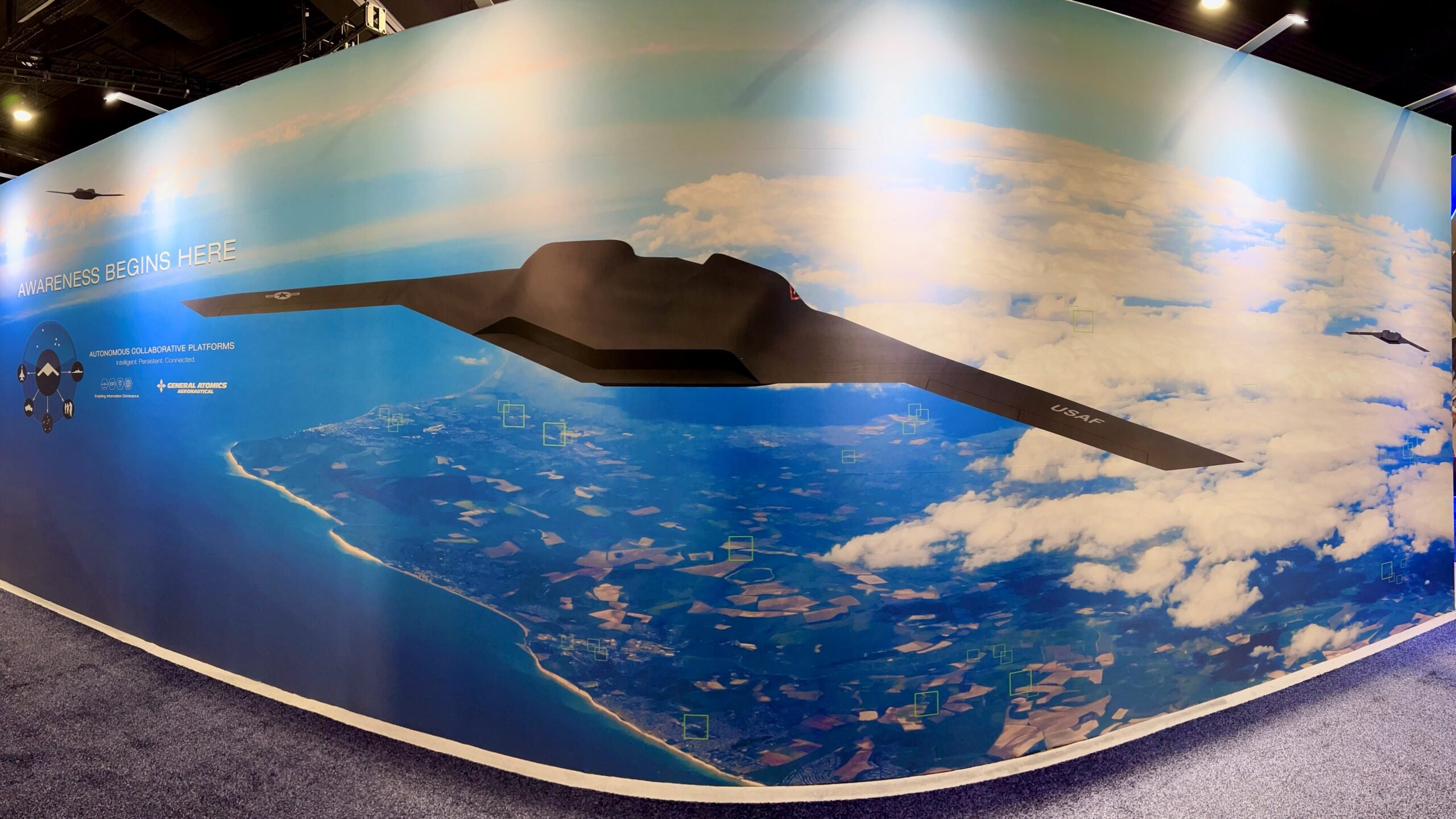
An image of General Atomics’ booth at the 2022 AFA conference, showing off a notional design of the MQ-Next. (General Atomics)
WASHINGTON — As it unveiled a new modular drone concept design last month, General Atomics also hinted at a new propulsion technology concept that a pair of top company executives believe has “game changing” potential.
The company’s featured product at the Air and Space Forces Association conference was its Gambit drone design, which features a common base from which four different designs can be produced. The base makes up around 70 percent of the aircraft designs, according to Dave Alexander, GA’s president of aeronautical systems, and Mike Atwood, the firm’s senior director of advanced programs, who talked to Breaking Defense on Sept. 21.
But on the wall of the company’s booth, concept art showed off a flying-wing shape associated most commonly with the B-2 or B-21 stealth bombers. Rather than part of Gambit, this design is part of what the company calls MQ-Next, which may end up incorporating a new propulsion effort for GA that Atwood hyped as a “completely disruptive technology.”
“We are working on hybrid electric propulsion,” Atwood said. “We believe that GA is going to pioneer a completely new way to propel airborne air-breathing [vehicles]. That will be unveiled in the coming years, but it is a completely disruptive technology. It uses a hybrid electric system where it’s basically a Tesla Model S and an RQ-170 got together and you have a fully electric aircraft” capable of traveling greater distances.
RELATED: Secretive B-21 bomber to be revealed to public in December
Alexander showed a graphic depicting the engine for the stealthy next-generation design. There are ducted fans buried inside the fuselage, with what he called “serpentine” inlets and exhausts — in essence, the ducts are twisted inside the aircraft in order to make sure the engine fans aren’t visible, and so won’t raise the RF signature. “If you were trying to look up the tailpipe, [you] couldn’t see it,” he said.
“The key to this design is [a] heavy fuel engine, driving very efficient generators and motors. And that way we can get fairly low [fan] speeds, get really good efficiency,” Alexander said. “So, this is game changer right here. This is a low-pressure ratio fan, so it’s a little tricky and we got to be careful with it. But we believe once we nail this, get the thrust out of it and installed weight, then that’ll drive that aircraft” to new lengths.
Specifically, Alexander said, the company expects the stealthy MQ-Next design to have 60 hours endurance, without needing to be refueled — a long-distance, long-on-station capability that he specifically noted would “help you cover the South China Sea.” In addition, the design should be able to take off from a 3,000 foot rough runway, meaning if it does need refueling, it could do so at the kind of small bases being looked at under the Air Force’s agile combat employment concept.
The mission set, Alexander summed up, is “in contested, in a stealthy required environment, with no dependence on in-flight refueling while addressing the tyranny of distance in the South China Sea.”
Feeding Back To Gambit
While the engine technology is still under development, the goal is to eventually feed what gets developed for MQ-Next back into the Gambit series, particularly the fourth Gambit model, which shares the flying-wing, stealthy design of the MQ-Next graphic.
Both Alexander and Atwood insisted multiple times during the interview that all of the Gambit package is in some form of production already. They also expressed confidence that should the Air Force want to move forward with the project, the company would have plenty of production space, pointing to a Sept. 20 announcement of a new facility opening at the companies Poway, Calif. location.
“We have the capacity to go two, three shifts. We have the square footage to provide whatever the Air Force needs. And we have the expansion capability where we’re located,” Alexander said.
The cost of the models — an ISR variant, one armed with air-to-air weapons, a third for an adversary air role, and a fourth with stealth and long-endurance capabilities — will be “significantly less” than GA’s MQ-9, Alexander said, estimating it will be in the “teens” of millions. Given that attrition is part of the concept, “you don’t want to get it so expensive that you’re afraid to use it,” he said.
The central core of Gambit — which Atwood referred to as the “skateboard” — comes pre-installed with a tailhook. However, both men insisted that they are not looking at getting a naval-variant of Gambit up and running in the near-term.
“I think, even if these things work perfectly from an aircraft, there’s no room on an aircraft carrier for these [designs],” Atwood said. “And culturally, the Navy is not ready for that. … You have other competitors that are trying to go down that road and largely failed. And so we’d rather do something that’s more straightforward.”
So why include the tailhook at all in this early design?
“For the future,” Atwood said. “We’d like to be future tolerant, [so] why would you not connect this structure through a common keel structure and be able to do that? if the world needs it, we want to be ready to project power from a carrier. We don’t think that’s the first step.”
Connecticut lawmakers to grill Army, Lockheed about job cuts at Sikorsky helicopter unit
“The Connecticut delegation has questions about why, with that [FY24] appropriation in hand, this happened,” said Rep. Joe Courtney, D-Conn.


























